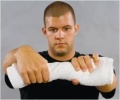Wringing test for lateral epicondylitis
Top Contributors - Abdul Wajid, Kim Jackson, George Prudden, Claire Knott and Wanda van Niekerk
Purpose[edit | edit source]
The Wringing Test is a general screening examination used to detect carpal tunnel syndrome, Lateral epicondylitis or arthropathy.
It is a basic test that can help narrow down the focus of a regional examination.
Technique[edit | edit source]
Patient should be awake and cooperative when performing the wringing test.
- Patient could be seated or standing during the test.
- Patient wrings a towel or wash cloth. With hands on both ends of the towel, the patient twists it in opposite directions.
- The examiner checks for any numbness, tingling or shooting pain on the wrist or over the elbow area.
Interpretation[edit | edit source]
Positive Wringing Test[edit | edit source]
- Paresthesia or the presence of numbness, tingling sensation or shooting electrical pain. This could indicate carpal tunnel syndrome.
- Elbow Pain could indicate epicondylitis or sprain or strain along the elbow area.[1]
- Wrist Pain could indicate arthropathy or sprain or strain along the wrist area.
References[edit | edit source]
- ↑ Warren, RF. Tennis elbow (epicondylitis): epidemiology and conservative treatment, in AAOS Symposium and Upper Extremity Injuries in Athletes, Pettrone, F.A., Ed. St. Louis: C.V. Mosby, 1986; 233-243. Level of Evidence: 1B







